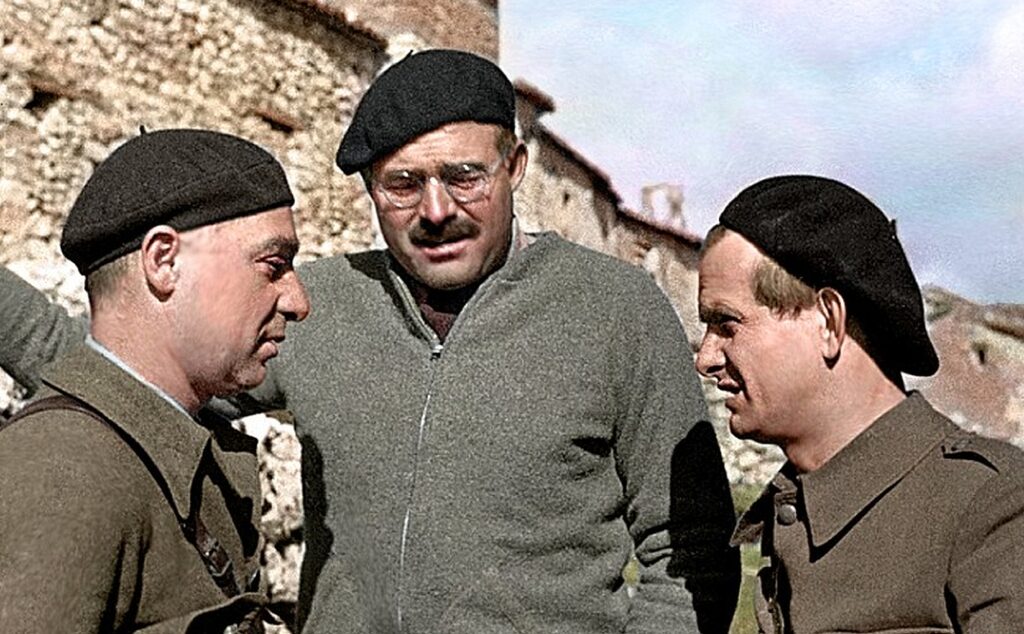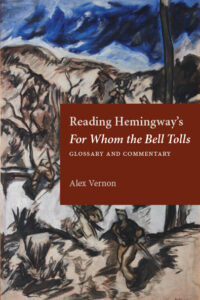“For Whom the Bell Tolls Is a Very Strange Book”—Alex Vernon, Hemingway Scholar

Ernest Hemingway with Ilya Ehrenburg and Gustav Regler during the Spanish Civil War, not dated, circa 1937. Hemingway Photograph Collection, John F. Kennedy Presidential Library and Museum, Boston. Public Domain. Colorized.
For Whom the Bell Tolls, Ernest Hemingway’s sprawling Spanish Civil War novel first published in October 1940, is still among his most widely read books. It is also widely misunderstood, says Hemingway scholar Alex Vernon. Vernon teaches at Hendrix College (Arkansas), is the author of Hemingway’s Second War and two army memoirs, and has just completed a 400-page Glossary and Commentary on For Whom the Bell Tolls, with an extensive introduction and sentence-by-sentence annotations, published by Kent State University Press. A good moment for a conversation about a controversial classic.
When did you first come across For Whom the Bell Tolls?
I read it at West Point, where I went to college and ended up writing two theses, one on Hemingway and one on Virginia Woolf. I loved Woolf, but Hemingway got me in trouble. You see, I had to teach classes to fellow cadets on the Honor Code that were intensely boring and predictable. One day it occurred to me to bring in case studies from two Hemingway novels: a passage about patriotic rhetoric as a lie from A Farewell to Arms and the scene in For Whom the Bell Tolls in which Anselmo, Robert Jordan’s Spanish guide, asks Jordan if the planes flying overhead are the Republic’s. Jordan first says yes, then realizes he’s wrong—but doesn’t correct himself. I thought these were good passages for future officers to ponder. My captain disagreed and chewed me out for it.
After your service in the First Gulf War, you went back to school and became an English Professor. Have you had a chance to teach the novel?
Here at Hendrix College, I decided years ago to include it in a senior seminar on Hemingway that I have since taught regularly. This forced me to study the Spanish Civil War. Over the years, I have felt increasingly drawn into what, as I always remind my students, is essentially a very strange book. Since it’s so securely ensconced in the canon, it’s easy to forget how strange it really is, but in my teaching and through this new Glossary and Commentary, I want to inhabit that strangeness and invite others to do the same.
What’s so strange about it?
The book has often been read in what we could call the John McCain way, assuming Robert Jordan is a relatively straightforward romantic hero. To be sure, he fights for the Communists, but that’s okay because he fights for what he believes in, plus he meets this amazing girl, María. To my mind, that straightforward reading doesn’t do justice to the book’s contradictions and complexities. For starters, for all Hemingway’s famous minimalism, this is an extremely maximalist novel. Yet if his minimalist style tends to obscure his characters, the same is true for this maximalist text, which also obscures how complicated Robert Jordan really is. The plot—the bombing of the bridge—tempts us to read fast, but once we slow down and pay attention to each sentence, each allusion, we run into some very weird things. Jordan’s relationship to María, for example, is bizarre. Queer studies scholars have had much to say about that.
 How much of this weirdness was Hemingway’s? I’m not only thinking of the gender dimension and Hemingway’s overperformed machismo, but also about his politics, which was more complicated than people tend to think, but doesn’t neatly map onto the Spanish political landscape, be it anarchists vs. communists, or Republicans vs. Francoists.
How much of this weirdness was Hemingway’s? I’m not only thinking of the gender dimension and Hemingway’s overperformed machismo, but also about his politics, which was more complicated than people tend to think, but doesn’t neatly map onto the Spanish political landscape, be it anarchists vs. communists, or Republicans vs. Francoists.
I think both dimensions apply. Although Hemingway’s queerness comes out more clearly in his later work, such as The Garden of Eden, it’s all over this book as well. I mean, if Hemingway had the vocabulary that we have now for the spectrum of expressions of gender and sexuality, how would Pilar identify? We can say something similar of Robert Jordan’s politics. In the novel’s first drafts, Jordan identified himself directly as a Communist. Hemingway removed that identification, changing it to antifascist, because he didn’t want to thwart his contract with the Book of the Month Club. But if you read closely, you realize that Jordan was fighting for the Republic before the International Brigades were formed. He was on the ground when the war started, and it seems pretty clear that he was fighting with, or alongside, the Fifth Regiment, a Communist outfit. On the other hand, Jordan tells us twice how much his sleeping bag costs—how bourgeois is that?—and becomes very possessive of María, wanting to marry her in a church even though she rejects church marriage and has undergone the traumatic experience of being made a “Bride of the Red Christ” by multiple assailants.
Since you mentioned the concessions to the Book of the Month Club, I’m wondering why you think Hemingway wrote the book. To support the antifascist cause? To make money? To prove himself as a writer?
Well, he certainly needed the money since he was divorcing Pauline and getting remarried to Martha Gellhorn. Proving himself was part of it too. Arguably, he had not written a “hit” since Farewell to Arms, in 1929. As to his politics, both during and after the war, it’s hard to say what went on in his head. I prefer to focus on Jordan, who is complicated enough. It’s also simpler than any of that. He loved making books, and this was the book that was in him.
The film, which came out in 1943 with Ingrid Bergman and Gary Cooper, must also have made him a lot of money.
That’s right.
To be honest, rewatching it today makes me cringe. The portrayal of the Spanish characters, especially, is pretty painful. How much of a cringe factor is there to overcome for your students when they read the book?
First, I should say that I only teach it in a senior seminar. I wouldn’t put it on freshmen or sophomores. But when I do teach the novel, I actually try to use the cringe factor to my advantage. We talk a lot about Robert Jordan’s relationship to the Spaniards, which has an unmistakable tinge of colonialism. To be blunt about it, Jordan clearly has a white savior complex. That makes the students cringe, and they are right. The same is true about the way Jordan treats Maria. What I want them to think about is to what extent Hemingway wanted us to cringe.
What do you hope your students get out of their reading?
That’s a great question. I sometimes think For Whom the Bell Tolls isn’t unlike Moby Dick. On the one hand, it’s a great meditation. On the other, it’s full of technical detail—the killing of whales, the politics of the Republic—that most people will glaze over. What I tell my students is that the book could have been a Red Badge of Courage-type story: almost apolitical, hardly without any references at all. But how realistic would that be? The devil is in the details, as they say. Hemingway knew the war in ways The Volunteer’s readers will appreciate better than most readers. And embedded in those many details are meditations on all kinds of issues, from religion to hunting and war and history. What I want my students to get out of reading the novel, in the end, is that sense of richness.
But not an idealization of war, for example.
Absolutely not—although plenty of people have read it in that way. Matt Gallagher, the writer, has said that this novel was one of the reasons why he joined the army and ended up in Iraq. He’s not the only veteran who has admitted such influence. I prefer readers to be skeptical of Robert Jordan as a military hero. It’s no coincidence that, before writing the novel in the late 1930s, he wrote letters in which he confessed he’d like to die but not to kill himself because he didn’t want to burden his children with that weight. But, in the end, isn’t that precisely what Robert Jordan ends up doing? He figures out a way to get killed without having to kill himself.
Sebastiaan Faber, the Chair of ALBA’s Board of Governors, teaches at Oberlin College.













